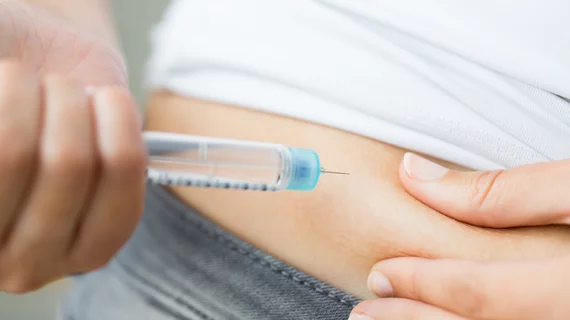A health plan-wide intervention to switch diabetic patients from costly new insulin products to older, more affordable drugs resulted in a marginal increase in hemoglobin A1c (hbA1c) levels but didn’t change the rate of hospital visits for dangerously high or low blood sugar, researchers reported Jan. 29 in JAMA.
The study, led by Harvard researcher Jing Luo, MPH, raises the possibility that many patients could be safely transitioned to human insulin products from newer analogue insulin therapies, which cost up to 10 times more. The intervention saved the health system millions of dollars per month on insulin and led to fewer patients meeting their Medicare Part D coverage gap, where patients pay a larger portion of their drug costs.
CareMore Health, a subsidiary of Anthem, implemented the changes between February and June of 2015 for a Medicare Advantage plan serving members in four states. Patients were incentivized to switch to human insulin with a copay of $0, compared to $37.50 with analogue insulin plus additional out-of-pocket payments if they reached the Part D coverage gap.
From 2014 through 2016—spanning both pre- and post-intervention—14,635 health plan members filled more than 221,000 insulin prescriptions. Human insulin use increased from 11 percent at baseline to 70 percent by the end of 2016, while the use of insulin analogues decreased from 89 percent to 30 percent.
Despite these changes, there was only a 0.14 percent bump in blood sugar levels at the population level. Participants were an average of 72.5 years old at baseline, 93 percent had type 2 diabetes and they had an average starting hbA1c of 8.46 percent.
Despite the small increase in A1c levels, the rate of slope of hospitalizations for hyperglycemic and hypoglycemic events didn’t change after most of the study participants switched their insulin products.
“The results of the current study add to a growing body of literature suggesting that human insulins may result in similar clinical outcomes compared with insulin analogues for many patients with type 2 diabetes,” wrote Harvard researcher Jing Luo, MD, MPH, and co-authors.
The authors added the 0.14 percent increase in hbA1c levels is below the 0.5 percent that has been suggested to be “clinically meaningful,” although they noted even small increases in blood sugar at the population level could be detrimental to individual patients who are exposed to higher A1c levels for extended periods.
Still, the neutral findings for clinical outcomes were in stark contrast to the financial impact of the intervention. Monthly expenditures for all insulin dispensed in the Medicare Advantage plan peaked at more than $3.4 million in December 2014 but dropped to $1.4 million by December 2016. That higher initial figure was driven by $3.2 million in analogue insulin expenditures compared to about $200,000 for human insulin. At the end of 2016, analogue spending dropped to $515,000 while human insulin spending increased to about $916,000.
Patients benefitted financially as well, with only 11.1 percent of members reaching the Part D coverage gap in 2016. More than 1 in 5—20.6 percent—reached the coverage gap in 2014. Out-of-pocket costs for insulin have come under scrutiny recently after one study reported that 25 percent of diabetics ration their insulin use because of cost concerns.
“These findings should prompt physicians and patients to reconsider which type of insulin is best,” Kasia J. Lipska, MD, MHS, wrote in a related JAMA editorial. “Human insulin may not be the optimal choice for everyone, but it could be a solution for many patients with diabetes. On the individual patient level, use of human insulin may minimize out-of-pocket spending, and, on the health care system level, it may allow insurers to maximize the value of diabetes care.”

